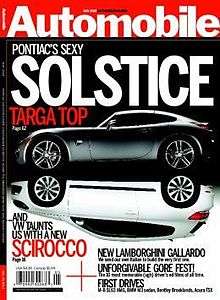AMG (automobile)
Between 1903 and 1905, the AMG automobile was a Swedish automobile manufactured by the AB Motorfabriken i Göteborg.
The company had been building stationary engines since 1897; in the first years of the new century they began importing French Richard-Brasier cars. Swedish production of the marque was considered, but the plans failed. A new model, using twin-cylinder air-cooled engines bought from the German Fafnir company, was shown in 1903. These tended to overheat, and as a result they were soon changed to a water-cooled model. The engines were the only automobile part that were imported; everything else was made in Sweden. Around 10 cars were built before the company failed in 1905; one was used regularly until 1928.

Car
A car is a wheeled, self-powered motor vehicle used for transportation and a product of the automotive industry. Most definitions of the term specify that cars are designed to run primarily on roads, to have seating for one to eight people, to typically have four wheels with tyres, and to be constructed principally for the transport of people rather than goods. The year 1886 is regarded as the birth year of the modern car. In that year, German inventor Karl Benz built the Benz Patent-Motorwagen. Cars did not become widely available until the early 20th century. One of the first cars that was accessible to the masses was the 1908 Model T, an American car manufactured by the Ford Motor Company. Cars were rapidly adopted in the United States of America, where they replaced animal-drawn carriages and carts, but took much longer to be accepted in Western Europe and other parts of the world.
Cars are equipped with controls used for driving, parking, passenger comfort and safety, and controlling a variety of lights. Over the decades, additional features and controls have been added to vehicles, making them progressively more complex. Examples include rear reversing cameras, air conditioning, navigation systems, and in car entertainment. Most cars in use in the 2010s are propelled by an internal combustion engine, fueled by deflagration of gasoline (also known as petrol) or diesel. Both fuels cause air pollution and are also blamed for contributing to climate change and global warming. Vehicles using alternative fuels such as ethanol flexible-fuel vehicles and natural gas vehicles are also gaining popularity in some countries. Electric cars, which were invented early in the history of the car, began to become commercially available in 2008.

Automobile (magazine)
Automobile is a United States-based automobile magazine published by TEN: The Enthusiast Network. A group of former employees of Car and Driver led by David E. Davis founded Automobile in 1986 with support from Rupert Murdoch's News Corporation– using the credo No Boring Cars.Automobile distinguishes itself as more of a lifestyle magazine than the other automotive publications, an editorial theme that Davis greatly expanded upon from his tenure as the editor of Car and Driver.
Unlike most other automobile magazines, Automobile does not often do instrumented tests of cars or provide much technical data. Instead, the reviews of vehicles are subjective experiential reports with the cars in their naturally intended, real world environment. Additionally, Automobile reserves a good portion of each issue covering vehicles no longer in production, but still relevant to collectors or automotive history as a whole. For example, the magazine includes features such as "Collectable Classic," an in-depth review of a particular older car, and reports from recent classic and antique car auctions. Automobile also has a regular column by former General Motors designer Robert Cumberford, who analyzes styling elements of current production models and show cars, often linking their design to those of older cars.
Automobile (disambiguation)
An automobile or car is a kind of wheeled motor vehicle. Automobile may also refer to:
AMG
AMG may refer to:
Automobiles
Mathematics and science
Media and entertainment

AMG-3
AMG-3 is an analgesic drug which is a cannabinoid agonist. It is a derivative of Δ8THC substituted with a dithiolane group on the 3-position side chain. AMG-3 is a potent agonist at both CB1 and CB2 receptors with a Ki of 0.32nM at CB1 and 0.52nM at CB2, and its particularly high binding affinity has led to it being used as a template for further structural development of novel cannabinoid drugs. It has sedative and analgesic effects, with analgesia lasting for up to 36 hours after administration.
References

AMG-41
AMG-41 is an analgesic drug which is a cannabinoid agonist. It is a derivative of Δ8-THC substituted with a cyclopropyl group on the C1'-position of the C3-alkyl side chain. AMG-41 is a potent agonist at both CB1 and CB2, with a Ki of 0.4nM at CB1 vs 0.9nM at CB2.
References
Podcasts:

